Analyzing Business Opportunities in Smart Cities: The Indian Model
VerifiedAdded on 2023/06/07
|31
|10207
|367
Report
AI Summary
This report explores the development of smart cities, focusing on the business opportunities within the Indian model. It provides an overview of smart cities globally, their history, and the rationale behind their emergence, emphasizing the role of technologies like IoT, AI, and data management. The report delves into the Indian smart city initiative, outlining its goals and conducting a market analysis with growth projections. Various business opportunities are identified, and case studies of smart cities around the world, such as Songdo, Masdar, Rio de Janeiro, Amsterdam and Madrid, are presented to provide insights into successful implementations and lessons learned. The report concludes by highlighting the potential benefits of smart city development, including improved public services, efficient resource management, and enhanced decision-making.

Running head: SMART CITIES AND BUSINESS OPPORTUNITIES (INDIAN MODEL)
Smart Cities and Business Opportunities (Indian Model)
Name of the Student
Name of the University
Author Note
Smart Cities and Business Opportunities (Indian Model)
Name of the Student
Name of the University
Author Note
Paraphrase This Document
Need a fresh take? Get an instant paraphrase of this document with our AI Paraphraser
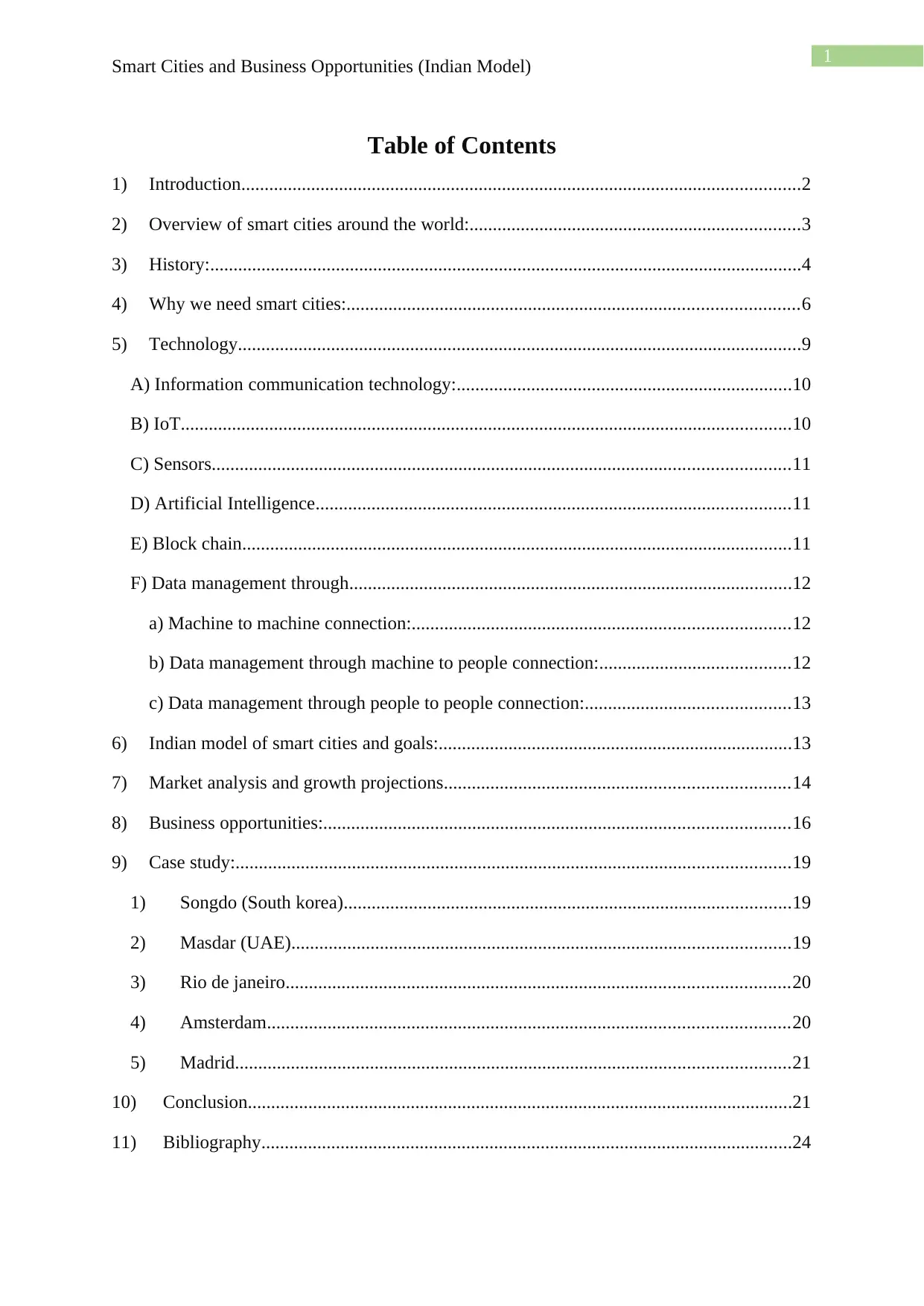
1
Smart Cities and Business Opportunities (Indian Model)
Table of Contents
1) Introduction........................................................................................................................2
2) Overview of smart cities around the world:.......................................................................3
3) History:...............................................................................................................................4
4) Why we need smart cities:.................................................................................................6
5) Technology.........................................................................................................................9
A) Information communication technology:........................................................................10
B) IoT...................................................................................................................................10
C) Sensors............................................................................................................................11
D) Artificial Intelligence......................................................................................................11
E) Block chain......................................................................................................................11
F) Data management through...............................................................................................12
a) Machine to machine connection:.................................................................................12
b) Data management through machine to people connection:.........................................12
c) Data management through people to people connection:............................................13
6) Indian model of smart cities and goals:............................................................................13
7) Market analysis and growth projections..........................................................................14
8) Business opportunities:....................................................................................................16
9) Case study:.......................................................................................................................19
1) Songdo (South korea)................................................................................................19
2) Masdar (UAE)...........................................................................................................19
3) Rio de janeiro............................................................................................................20
4) Amsterdam................................................................................................................20
5) Madrid.......................................................................................................................21
10) Conclusion.....................................................................................................................21
11) Bibliography..................................................................................................................24
Smart Cities and Business Opportunities (Indian Model)
Table of Contents
1) Introduction........................................................................................................................2
2) Overview of smart cities around the world:.......................................................................3
3) History:...............................................................................................................................4
4) Why we need smart cities:.................................................................................................6
5) Technology.........................................................................................................................9
A) Information communication technology:........................................................................10
B) IoT...................................................................................................................................10
C) Sensors............................................................................................................................11
D) Artificial Intelligence......................................................................................................11
E) Block chain......................................................................................................................11
F) Data management through...............................................................................................12
a) Machine to machine connection:.................................................................................12
b) Data management through machine to people connection:.........................................12
c) Data management through people to people connection:............................................13
6) Indian model of smart cities and goals:............................................................................13
7) Market analysis and growth projections..........................................................................14
8) Business opportunities:....................................................................................................16
9) Case study:.......................................................................................................................19
1) Songdo (South korea)................................................................................................19
2) Masdar (UAE)...........................................................................................................19
3) Rio de janeiro............................................................................................................20
4) Amsterdam................................................................................................................20
5) Madrid.......................................................................................................................21
10) Conclusion.....................................................................................................................21
11) Bibliography..................................................................................................................24
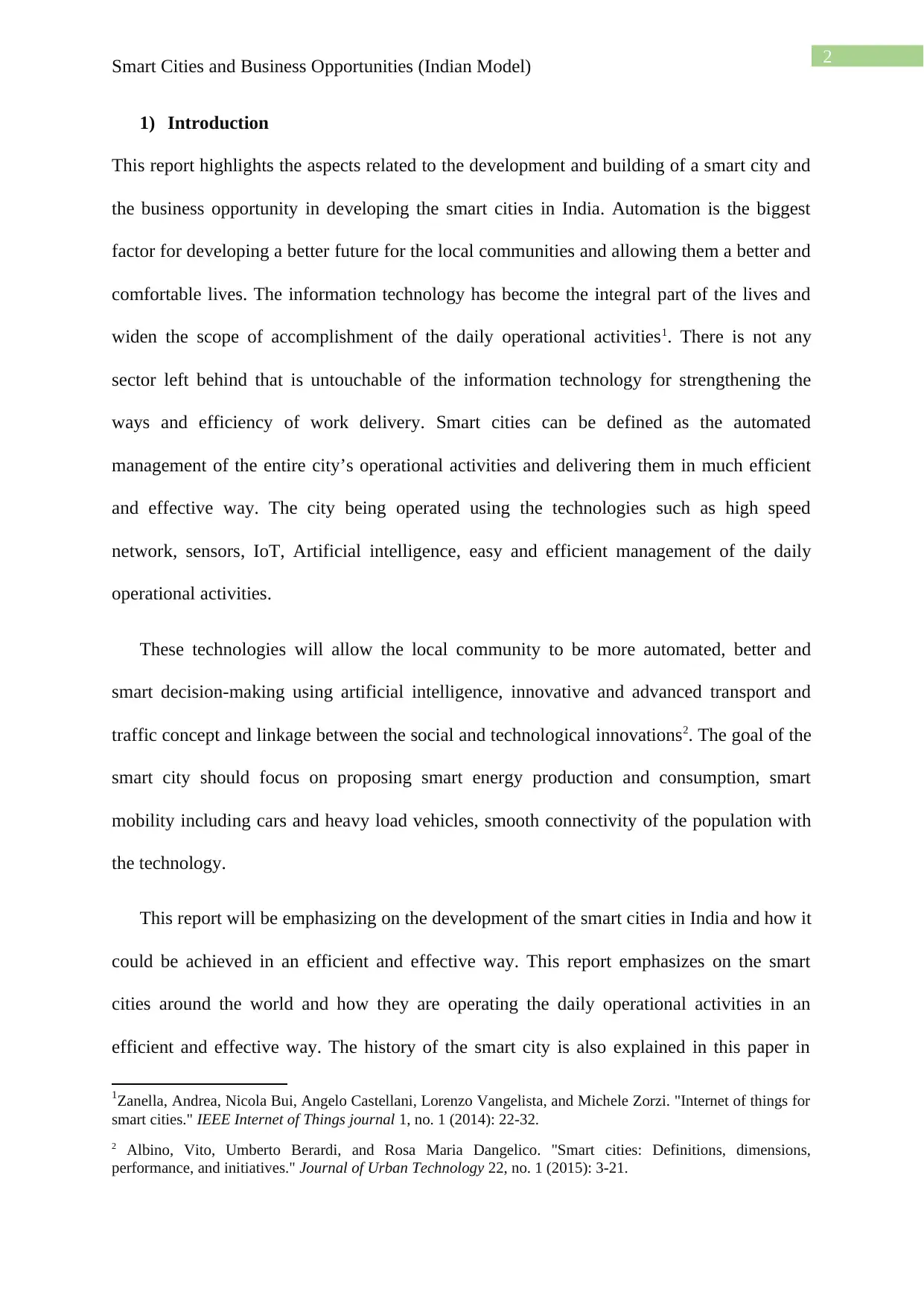
2
Smart Cities and Business Opportunities (Indian Model)
1) Introduction
This report highlights the aspects related to the development and building of a smart city and
the business opportunity in developing the smart cities in India. Automation is the biggest
factor for developing a better future for the local communities and allowing them a better and
comfortable lives. The information technology has become the integral part of the lives and
widen the scope of accomplishment of the daily operational activities1. There is not any
sector left behind that is untouchable of the information technology for strengthening the
ways and efficiency of work delivery. Smart cities can be defined as the automated
management of the entire city’s operational activities and delivering them in much efficient
and effective way. The city being operated using the technologies such as high speed
network, sensors, IoT, Artificial intelligence, easy and efficient management of the daily
operational activities.
These technologies will allow the local community to be more automated, better and
smart decision-making using artificial intelligence, innovative and advanced transport and
traffic concept and linkage between the social and technological innovations2. The goal of the
smart city should focus on proposing smart energy production and consumption, smart
mobility including cars and heavy load vehicles, smooth connectivity of the population with
the technology.
This report will be emphasizing on the development of the smart cities in India and how it
could be achieved in an efficient and effective way. This report emphasizes on the smart
cities around the world and how they are operating the daily operational activities in an
efficient and effective way. The history of the smart city is also explained in this paper in
1Zanella, Andrea, Nicola Bui, Angelo Castellani, Lorenzo Vangelista, and Michele Zorzi. "Internet of things for
smart cities." IEEE Internet of Things journal 1, no. 1 (2014): 22-32.
2 Albino, Vito, Umberto Berardi, and Rosa Maria Dangelico. "Smart cities: Definitions, dimensions,
performance, and initiatives." Journal of Urban Technology 22, no. 1 (2015): 3-21.
Smart Cities and Business Opportunities (Indian Model)
1) Introduction
This report highlights the aspects related to the development and building of a smart city and
the business opportunity in developing the smart cities in India. Automation is the biggest
factor for developing a better future for the local communities and allowing them a better and
comfortable lives. The information technology has become the integral part of the lives and
widen the scope of accomplishment of the daily operational activities1. There is not any
sector left behind that is untouchable of the information technology for strengthening the
ways and efficiency of work delivery. Smart cities can be defined as the automated
management of the entire city’s operational activities and delivering them in much efficient
and effective way. The city being operated using the technologies such as high speed
network, sensors, IoT, Artificial intelligence, easy and efficient management of the daily
operational activities.
These technologies will allow the local community to be more automated, better and
smart decision-making using artificial intelligence, innovative and advanced transport and
traffic concept and linkage between the social and technological innovations2. The goal of the
smart city should focus on proposing smart energy production and consumption, smart
mobility including cars and heavy load vehicles, smooth connectivity of the population with
the technology.
This report will be emphasizing on the development of the smart cities in India and how it
could be achieved in an efficient and effective way. This report emphasizes on the smart
cities around the world and how they are operating the daily operational activities in an
efficient and effective way. The history of the smart city is also explained in this paper in
1Zanella, Andrea, Nicola Bui, Angelo Castellani, Lorenzo Vangelista, and Michele Zorzi. "Internet of things for
smart cities." IEEE Internet of Things journal 1, no. 1 (2014): 22-32.
2 Albino, Vito, Umberto Berardi, and Rosa Maria Dangelico. "Smart cities: Definitions, dimensions,
performance, and initiatives." Journal of Urban Technology 22, no. 1 (2015): 3-21.
⊘ This is a preview!⊘
Do you want full access?
Subscribe today to unlock all pages.

Trusted by 1+ million students worldwide
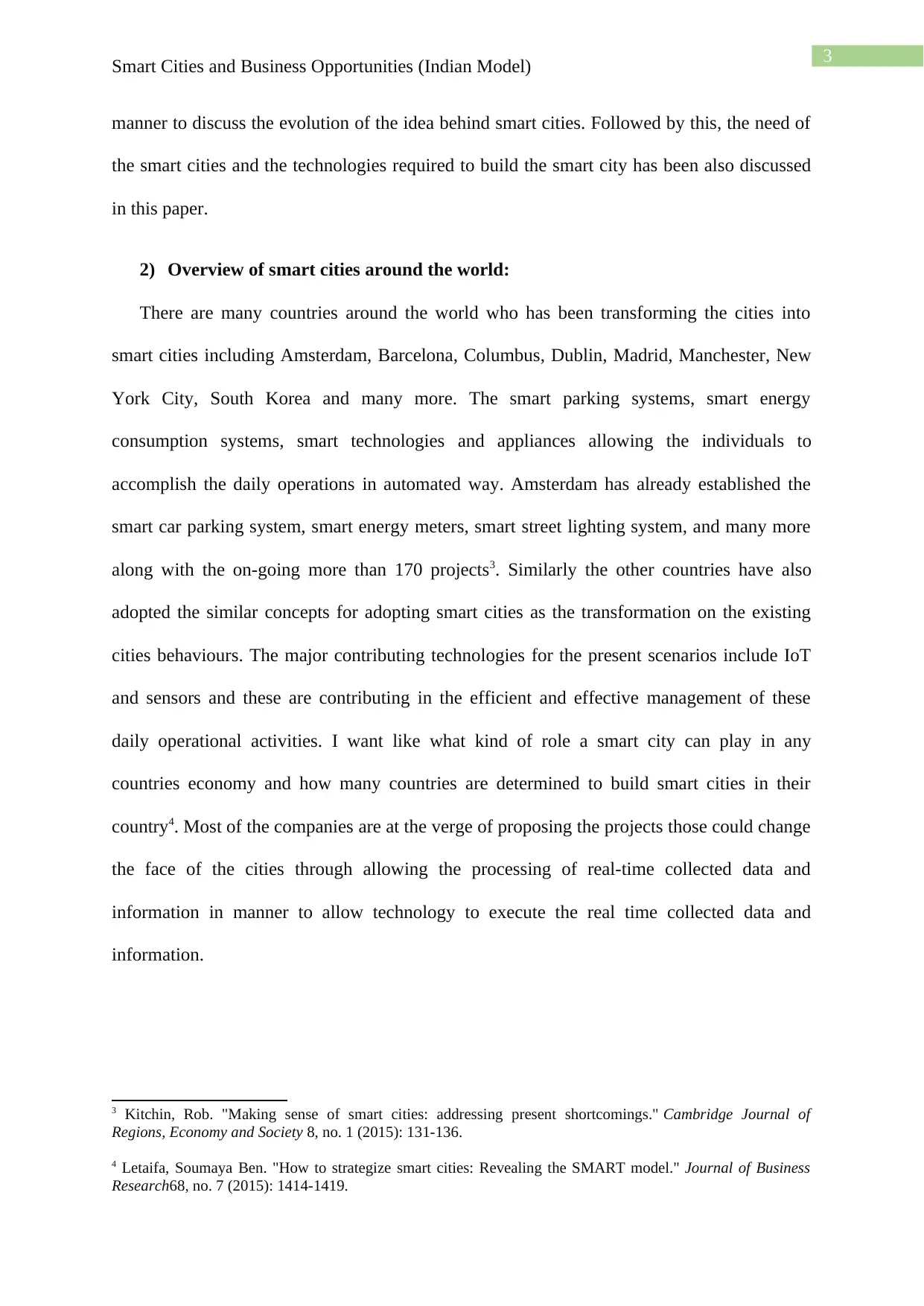
3
Smart Cities and Business Opportunities (Indian Model)
manner to discuss the evolution of the idea behind smart cities. Followed by this, the need of
the smart cities and the technologies required to build the smart city has been also discussed
in this paper.
2) Overview of smart cities around the world:
There are many countries around the world who has been transforming the cities into
smart cities including Amsterdam, Barcelona, Columbus, Dublin, Madrid, Manchester, New
York City, South Korea and many more. The smart parking systems, smart energy
consumption systems, smart technologies and appliances allowing the individuals to
accomplish the daily operations in automated way. Amsterdam has already established the
smart car parking system, smart energy meters, smart street lighting system, and many more
along with the on-going more than 170 projects3. Similarly the other countries have also
adopted the similar concepts for adopting smart cities as the transformation on the existing
cities behaviours. The major contributing technologies for the present scenarios include IoT
and sensors and these are contributing in the efficient and effective management of these
daily operational activities. I want like what kind of role a smart city can play in any
countries economy and how many countries are determined to build smart cities in their
country4. Most of the companies are at the verge of proposing the projects those could change
the face of the cities through allowing the processing of real-time collected data and
information in manner to allow technology to execute the real time collected data and
information.
3 Kitchin, Rob. "Making sense of smart cities: addressing present shortcomings." Cambridge Journal of
Regions, Economy and Society 8, no. 1 (2015): 131-136.
4 Letaifa, Soumaya Ben. "How to strategize smart cities: Revealing the SMART model." Journal of Business
Research68, no. 7 (2015): 1414-1419.
Smart Cities and Business Opportunities (Indian Model)
manner to discuss the evolution of the idea behind smart cities. Followed by this, the need of
the smart cities and the technologies required to build the smart city has been also discussed
in this paper.
2) Overview of smart cities around the world:
There are many countries around the world who has been transforming the cities into
smart cities including Amsterdam, Barcelona, Columbus, Dublin, Madrid, Manchester, New
York City, South Korea and many more. The smart parking systems, smart energy
consumption systems, smart technologies and appliances allowing the individuals to
accomplish the daily operations in automated way. Amsterdam has already established the
smart car parking system, smart energy meters, smart street lighting system, and many more
along with the on-going more than 170 projects3. Similarly the other countries have also
adopted the similar concepts for adopting smart cities as the transformation on the existing
cities behaviours. The major contributing technologies for the present scenarios include IoT
and sensors and these are contributing in the efficient and effective management of these
daily operational activities. I want like what kind of role a smart city can play in any
countries economy and how many countries are determined to build smart cities in their
country4. Most of the companies are at the verge of proposing the projects those could change
the face of the cities through allowing the processing of real-time collected data and
information in manner to allow technology to execute the real time collected data and
information.
3 Kitchin, Rob. "Making sense of smart cities: addressing present shortcomings." Cambridge Journal of
Regions, Economy and Society 8, no. 1 (2015): 131-136.
4 Letaifa, Soumaya Ben. "How to strategize smart cities: Revealing the SMART model." Journal of Business
Research68, no. 7 (2015): 1414-1419.
Paraphrase This Document
Need a fresh take? Get an instant paraphrase of this document with our AI Paraphraser
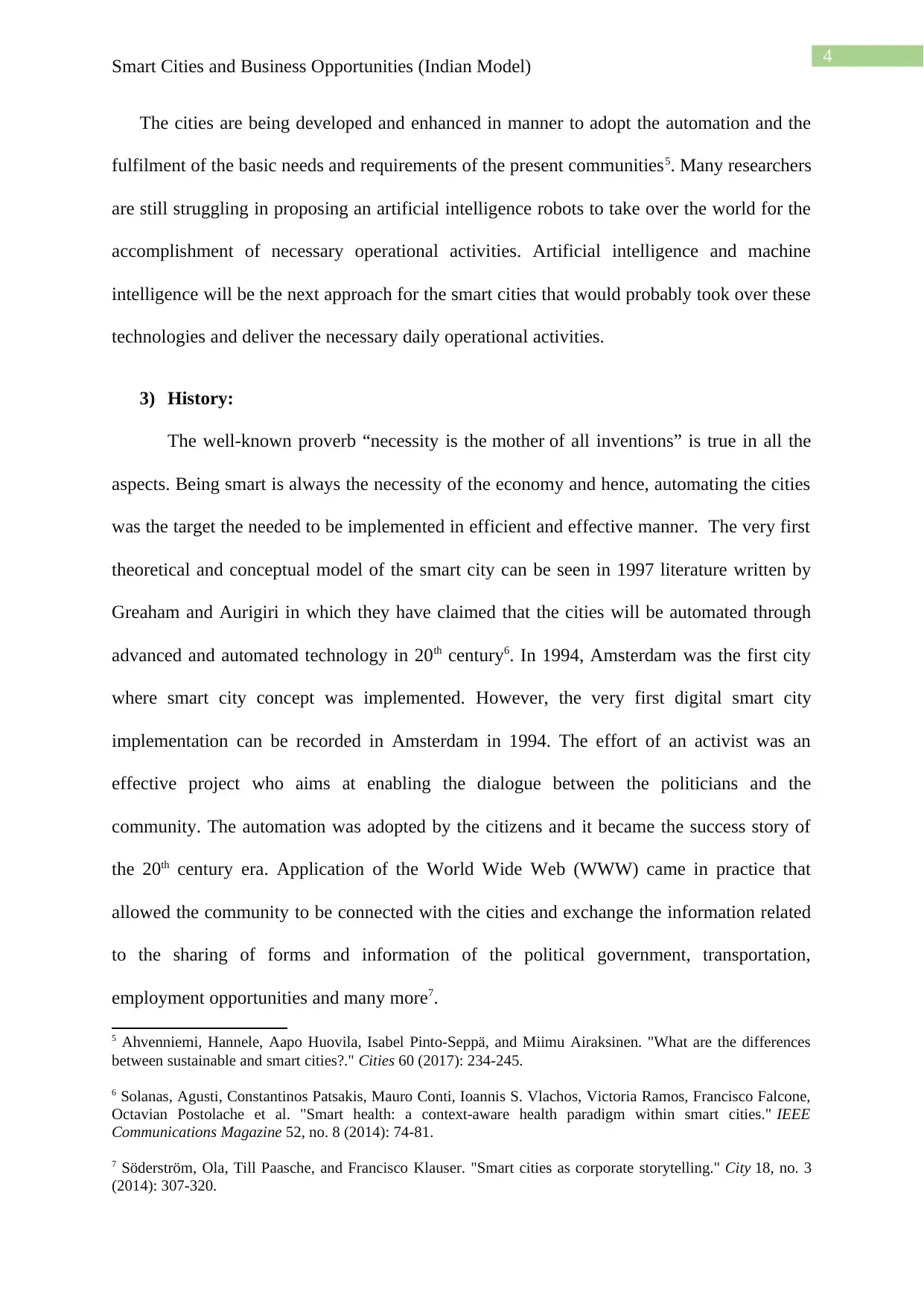
4
Smart Cities and Business Opportunities (Indian Model)
The cities are being developed and enhanced in manner to adopt the automation and the
fulfilment of the basic needs and requirements of the present communities5. Many researchers
are still struggling in proposing an artificial intelligence robots to take over the world for the
accomplishment of necessary operational activities. Artificial intelligence and machine
intelligence will be the next approach for the smart cities that would probably took over these
technologies and deliver the necessary daily operational activities.
3) History:
The well-known proverb “necessity is the mother of all inventions” is true in all the
aspects. Being smart is always the necessity of the economy and hence, automating the cities
was the target the needed to be implemented in efficient and effective manner. The very first
theoretical and conceptual model of the smart city can be seen in 1997 literature written by
Greaham and Aurigiri in which they have claimed that the cities will be automated through
advanced and automated technology in 20th century6. In 1994, Amsterdam was the first city
where smart city concept was implemented. However, the very first digital smart city
implementation can be recorded in Amsterdam in 1994. The effort of an activist was an
effective project who aims at enabling the dialogue between the politicians and the
community. The automation was adopted by the citizens and it became the success story of
the 20th century era. Application of the World Wide Web (WWW) came in practice that
allowed the community to be connected with the cities and exchange the information related
to the sharing of forms and information of the political government, transportation,
employment opportunities and many more7.
5 Ahvenniemi, Hannele, Aapo Huovila, Isabel Pinto-Seppä, and Miimu Airaksinen. "What are the differences
between sustainable and smart cities?." Cities 60 (2017): 234-245.
6 Solanas, Agusti, Constantinos Patsakis, Mauro Conti, Ioannis S. Vlachos, Victoria Ramos, Francisco Falcone,
Octavian Postolache et al. "Smart health: a context-aware health paradigm within smart cities." IEEE
Communications Magazine 52, no. 8 (2014): 74-81.
7 Söderström, Ola, Till Paasche, and Francisco Klauser. "Smart cities as corporate storytelling." City 18, no. 3
(2014): 307-320.
Smart Cities and Business Opportunities (Indian Model)
The cities are being developed and enhanced in manner to adopt the automation and the
fulfilment of the basic needs and requirements of the present communities5. Many researchers
are still struggling in proposing an artificial intelligence robots to take over the world for the
accomplishment of necessary operational activities. Artificial intelligence and machine
intelligence will be the next approach for the smart cities that would probably took over these
technologies and deliver the necessary daily operational activities.
3) History:
The well-known proverb “necessity is the mother of all inventions” is true in all the
aspects. Being smart is always the necessity of the economy and hence, automating the cities
was the target the needed to be implemented in efficient and effective manner. The very first
theoretical and conceptual model of the smart city can be seen in 1997 literature written by
Greaham and Aurigiri in which they have claimed that the cities will be automated through
advanced and automated technology in 20th century6. In 1994, Amsterdam was the first city
where smart city concept was implemented. However, the very first digital smart city
implementation can be recorded in Amsterdam in 1994. The effort of an activist was an
effective project who aims at enabling the dialogue between the politicians and the
community. The automation was adopted by the citizens and it became the success story of
the 20th century era. Application of the World Wide Web (WWW) came in practice that
allowed the community to be connected with the cities and exchange the information related
to the sharing of forms and information of the political government, transportation,
employment opportunities and many more7.
5 Ahvenniemi, Hannele, Aapo Huovila, Isabel Pinto-Seppä, and Miimu Airaksinen. "What are the differences
between sustainable and smart cities?." Cities 60 (2017): 234-245.
6 Solanas, Agusti, Constantinos Patsakis, Mauro Conti, Ioannis S. Vlachos, Victoria Ramos, Francisco Falcone,
Octavian Postolache et al. "Smart health: a context-aware health paradigm within smart cities." IEEE
Communications Magazine 52, no. 8 (2014): 74-81.
7 Söderström, Ola, Till Paasche, and Francisco Klauser. "Smart cities as corporate storytelling." City 18, no. 3
(2014): 307-320.
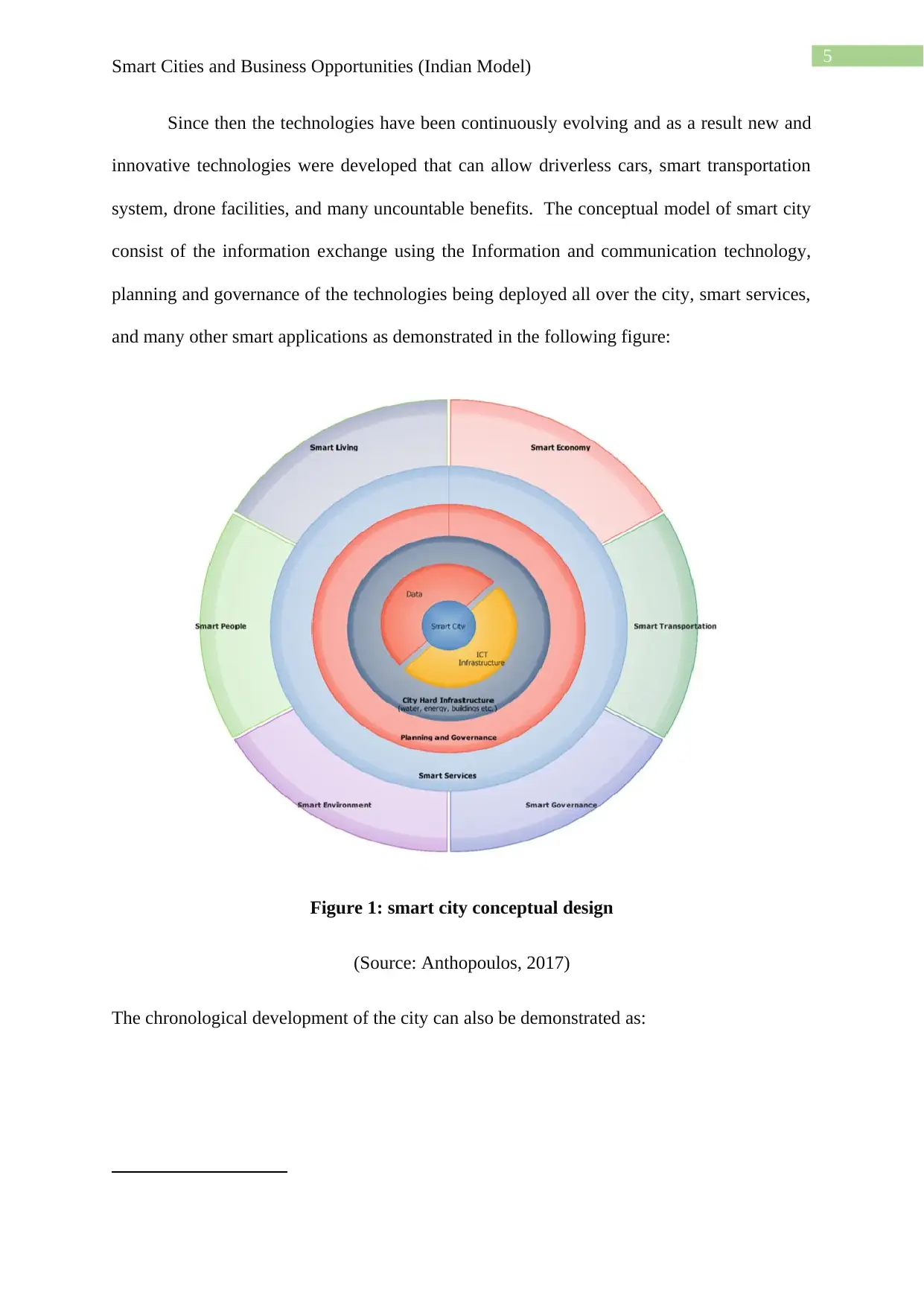
5
Smart Cities and Business Opportunities (Indian Model)
Since then the technologies have been continuously evolving and as a result new and
innovative technologies were developed that can allow driverless cars, smart transportation
system, drone facilities, and many uncountable benefits. The conceptual model of smart city
consist of the information exchange using the Information and communication technology,
planning and governance of the technologies being deployed all over the city, smart services,
and many other smart applications as demonstrated in the following figure:
Figure 1: smart city conceptual design
(Source: Anthopoulos, 2017)
The chronological development of the city can also be demonstrated as:
Smart Cities and Business Opportunities (Indian Model)
Since then the technologies have been continuously evolving and as a result new and
innovative technologies were developed that can allow driverless cars, smart transportation
system, drone facilities, and many uncountable benefits. The conceptual model of smart city
consist of the information exchange using the Information and communication technology,
planning and governance of the technologies being deployed all over the city, smart services,
and many other smart applications as demonstrated in the following figure:
Figure 1: smart city conceptual design
(Source: Anthopoulos, 2017)
The chronological development of the city can also be demonstrated as:
⊘ This is a preview!⊘
Do you want full access?
Subscribe today to unlock all pages.

Trusted by 1+ million students worldwide
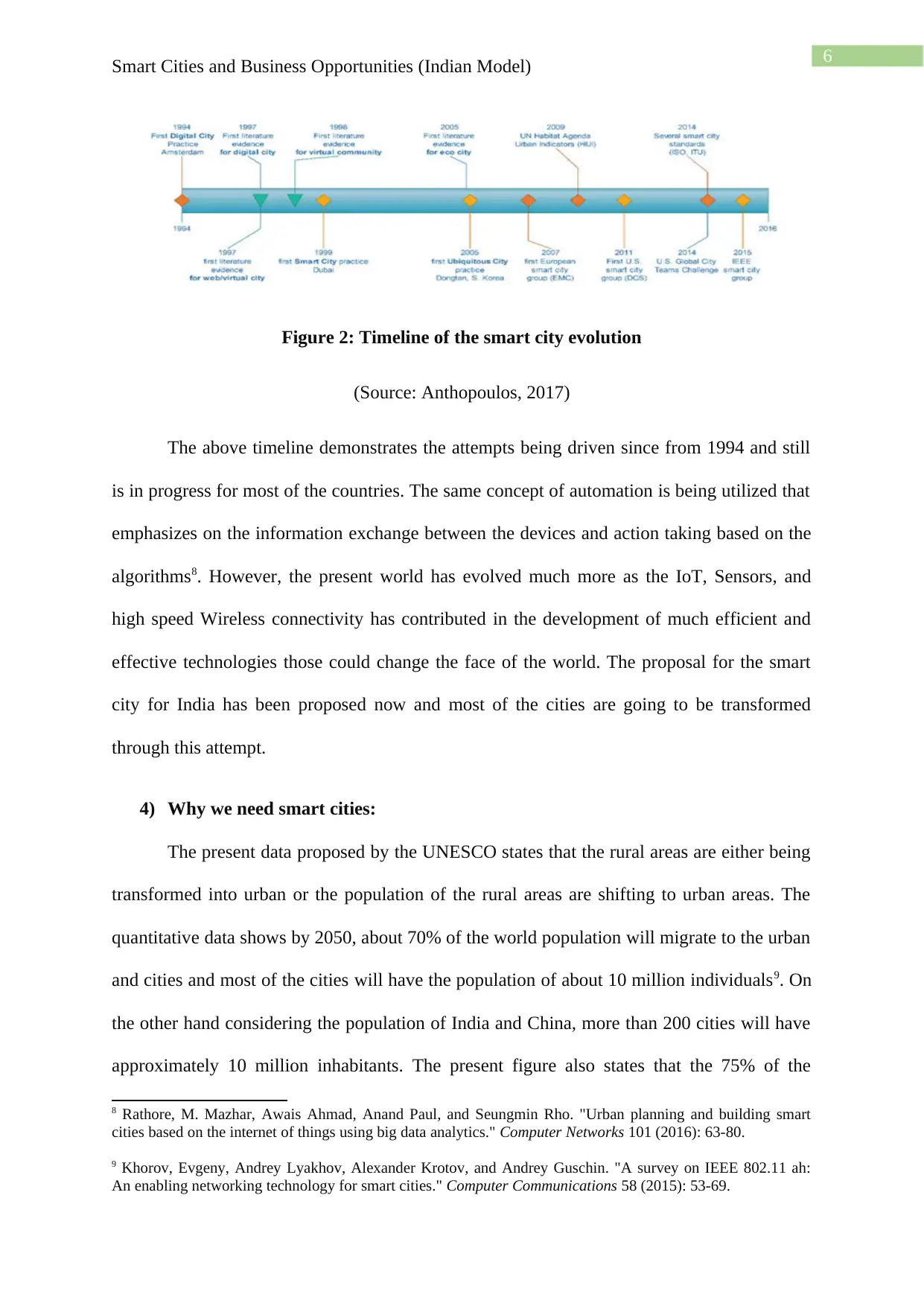
6
Smart Cities and Business Opportunities (Indian Model)
Figure 2: Timeline of the smart city evolution
(Source: Anthopoulos, 2017)
The above timeline demonstrates the attempts being driven since from 1994 and still
is in progress for most of the countries. The same concept of automation is being utilized that
emphasizes on the information exchange between the devices and action taking based on the
algorithms8. However, the present world has evolved much more as the IoT, Sensors, and
high speed Wireless connectivity has contributed in the development of much efficient and
effective technologies those could change the face of the world. The proposal for the smart
city for India has been proposed now and most of the cities are going to be transformed
through this attempt.
4) Why we need smart cities:
The present data proposed by the UNESCO states that the rural areas are either being
transformed into urban or the population of the rural areas are shifting to urban areas. The
quantitative data shows by 2050, about 70% of the world population will migrate to the urban
and cities and most of the cities will have the population of about 10 million individuals9. On
the other hand considering the population of India and China, more than 200 cities will have
approximately 10 million inhabitants. The present figure also states that the 75% of the
8 Rathore, M. Mazhar, Awais Ahmad, Anand Paul, and Seungmin Rho. "Urban planning and building smart
cities based on the internet of things using big data analytics." Computer Networks 101 (2016): 63-80.
9 Khorov, Evgeny, Andrey Lyakhov, Alexander Krotov, and Andrey Guschin. "A survey on IEEE 802.11 ah:
An enabling networking technology for smart cities." Computer Communications 58 (2015): 53-69.
Smart Cities and Business Opportunities (Indian Model)
Figure 2: Timeline of the smart city evolution
(Source: Anthopoulos, 2017)
The above timeline demonstrates the attempts being driven since from 1994 and still
is in progress for most of the countries. The same concept of automation is being utilized that
emphasizes on the information exchange between the devices and action taking based on the
algorithms8. However, the present world has evolved much more as the IoT, Sensors, and
high speed Wireless connectivity has contributed in the development of much efficient and
effective technologies those could change the face of the world. The proposal for the smart
city for India has been proposed now and most of the cities are going to be transformed
through this attempt.
4) Why we need smart cities:
The present data proposed by the UNESCO states that the rural areas are either being
transformed into urban or the population of the rural areas are shifting to urban areas. The
quantitative data shows by 2050, about 70% of the world population will migrate to the urban
and cities and most of the cities will have the population of about 10 million individuals9. On
the other hand considering the population of India and China, more than 200 cities will have
approximately 10 million inhabitants. The present figure also states that the 75% of the
8 Rathore, M. Mazhar, Awais Ahmad, Anand Paul, and Seungmin Rho. "Urban planning and building smart
cities based on the internet of things using big data analytics." Computer Networks 101 (2016): 63-80.
9 Khorov, Evgeny, Andrey Lyakhov, Alexander Krotov, and Andrey Guschin. "A survey on IEEE 802.11 ah:
An enabling networking technology for smart cities." Computer Communications 58 (2015): 53-69.
Paraphrase This Document
Need a fresh take? Get an instant paraphrase of this document with our AI Paraphraser
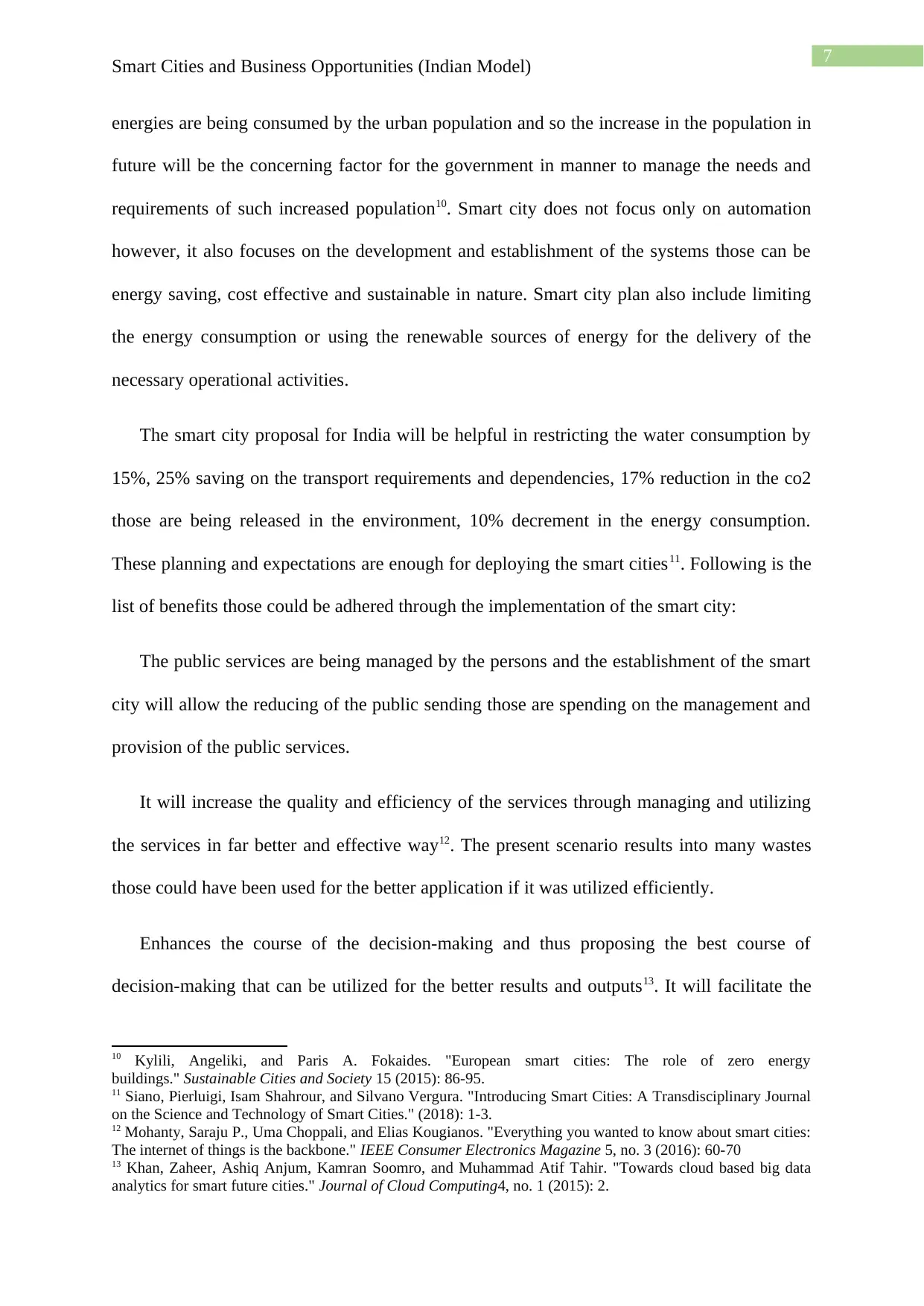
7
Smart Cities and Business Opportunities (Indian Model)
energies are being consumed by the urban population and so the increase in the population in
future will be the concerning factor for the government in manner to manage the needs and
requirements of such increased population10. Smart city does not focus only on automation
however, it also focuses on the development and establishment of the systems those can be
energy saving, cost effective and sustainable in nature. Smart city plan also include limiting
the energy consumption or using the renewable sources of energy for the delivery of the
necessary operational activities.
The smart city proposal for India will be helpful in restricting the water consumption by
15%, 25% saving on the transport requirements and dependencies, 17% reduction in the co2
those are being released in the environment, 10% decrement in the energy consumption.
These planning and expectations are enough for deploying the smart cities11. Following is the
list of benefits those could be adhered through the implementation of the smart city:
The public services are being managed by the persons and the establishment of the smart
city will allow the reducing of the public sending those are spending on the management and
provision of the public services.
It will increase the quality and efficiency of the services through managing and utilizing
the services in far better and effective way12. The present scenario results into many wastes
those could have been used for the better application if it was utilized efficiently.
Enhances the course of the decision-making and thus proposing the best course of
decision-making that can be utilized for the better results and outputs13. It will facilitate the
10 Kylili, Angeliki, and Paris A. Fokaides. "European smart cities: The role of zero energy
buildings." Sustainable Cities and Society 15 (2015): 86-95.
11 Siano, Pierluigi, Isam Shahrour, and Silvano Vergura. "Introducing Smart Cities: A Transdisciplinary Journal
on the Science and Technology of Smart Cities." (2018): 1-3.
12 Mohanty, Saraju P., Uma Choppali, and Elias Kougianos. "Everything you wanted to know about smart cities:
The internet of things is the backbone." IEEE Consumer Electronics Magazine 5, no. 3 (2016): 60-70
13 Khan, Zaheer, Ashiq Anjum, Kamran Soomro, and Muhammad Atif Tahir. "Towards cloud based big data
analytics for smart future cities." Journal of Cloud Computing4, no. 1 (2015): 2.
Smart Cities and Business Opportunities (Indian Model)
energies are being consumed by the urban population and so the increase in the population in
future will be the concerning factor for the government in manner to manage the needs and
requirements of such increased population10. Smart city does not focus only on automation
however, it also focuses on the development and establishment of the systems those can be
energy saving, cost effective and sustainable in nature. Smart city plan also include limiting
the energy consumption or using the renewable sources of energy for the delivery of the
necessary operational activities.
The smart city proposal for India will be helpful in restricting the water consumption by
15%, 25% saving on the transport requirements and dependencies, 17% reduction in the co2
those are being released in the environment, 10% decrement in the energy consumption.
These planning and expectations are enough for deploying the smart cities11. Following is the
list of benefits those could be adhered through the implementation of the smart city:
The public services are being managed by the persons and the establishment of the smart
city will allow the reducing of the public sending those are spending on the management and
provision of the public services.
It will increase the quality and efficiency of the services through managing and utilizing
the services in far better and effective way12. The present scenario results into many wastes
those could have been used for the better application if it was utilized efficiently.
Enhances the course of the decision-making and thus proposing the best course of
decision-making that can be utilized for the better results and outputs13. It will facilitate the
10 Kylili, Angeliki, and Paris A. Fokaides. "European smart cities: The role of zero energy
buildings." Sustainable Cities and Society 15 (2015): 86-95.
11 Siano, Pierluigi, Isam Shahrour, and Silvano Vergura. "Introducing Smart Cities: A Transdisciplinary Journal
on the Science and Technology of Smart Cities." (2018): 1-3.
12 Mohanty, Saraju P., Uma Choppali, and Elias Kougianos. "Everything you wanted to know about smart cities:
The internet of things is the backbone." IEEE Consumer Electronics Magazine 5, no. 3 (2016): 60-70
13 Khan, Zaheer, Ashiq Anjum, Kamran Soomro, and Muhammad Atif Tahir. "Towards cloud based big data
analytics for smart future cities." Journal of Cloud Computing4, no. 1 (2015): 2.
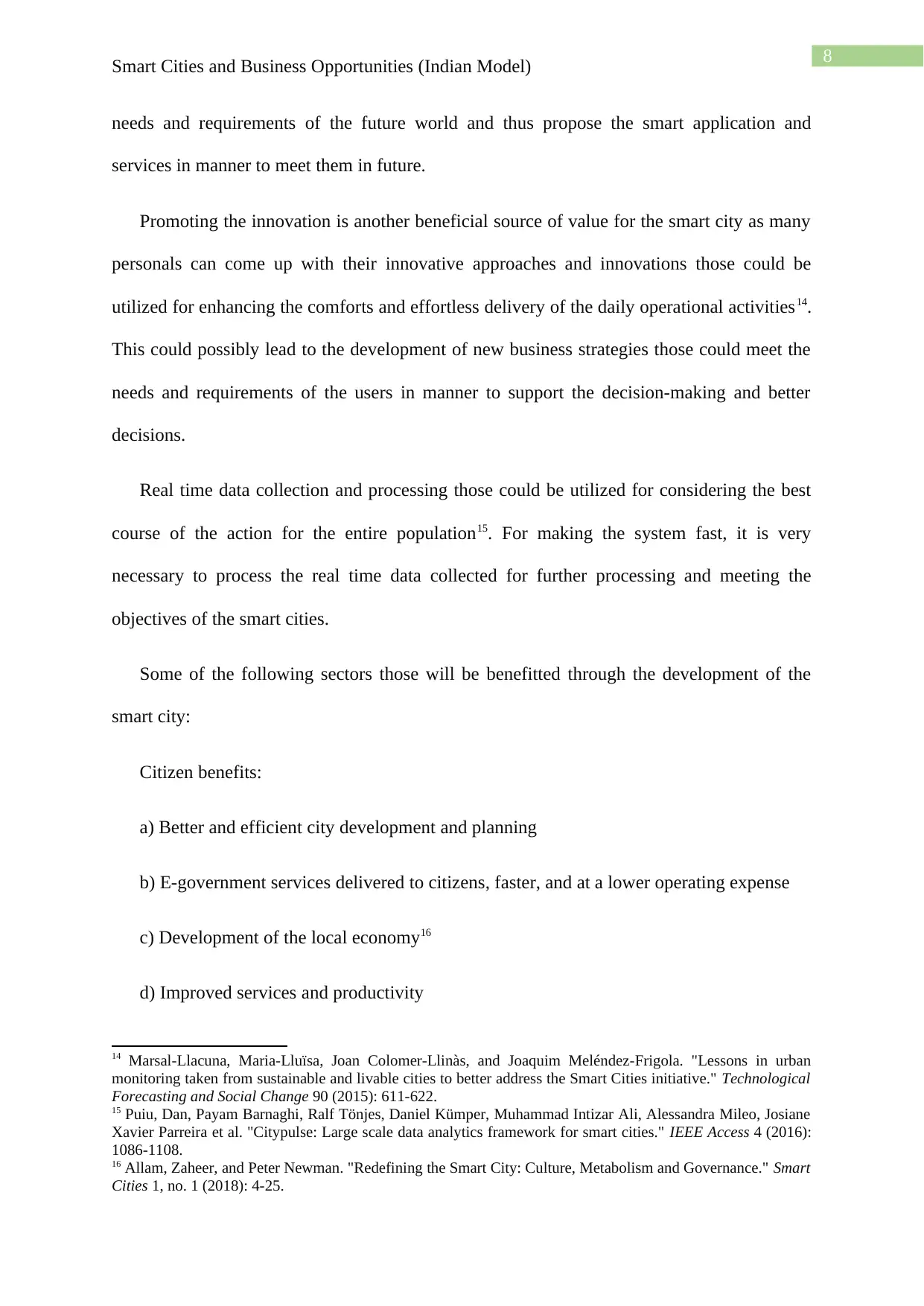
8
Smart Cities and Business Opportunities (Indian Model)
needs and requirements of the future world and thus propose the smart application and
services in manner to meet them in future.
Promoting the innovation is another beneficial source of value for the smart city as many
personals can come up with their innovative approaches and innovations those could be
utilized for enhancing the comforts and effortless delivery of the daily operational activities14.
This could possibly lead to the development of new business strategies those could meet the
needs and requirements of the users in manner to support the decision-making and better
decisions.
Real time data collection and processing those could be utilized for considering the best
course of the action for the entire population15. For making the system fast, it is very
necessary to process the real time data collected for further processing and meeting the
objectives of the smart cities.
Some of the following sectors those will be benefitted through the development of the
smart city:
Citizen benefits:
a) Better and efficient city development and planning
b) E-government services delivered to citizens, faster, and at a lower operating expense
c) Development of the local economy16
d) Improved services and productivity
14 Marsal-Llacuna, Maria-Lluïsa, Joan Colomer-Llinàs, and Joaquim Meléndez-Frigola. "Lessons in urban
monitoring taken from sustainable and livable cities to better address the Smart Cities initiative." Technological
Forecasting and Social Change 90 (2015): 611-622.
15 Puiu, Dan, Payam Barnaghi, Ralf Tönjes, Daniel Kümper, Muhammad Intizar Ali, Alessandra Mileo, Josiane
Xavier Parreira et al. "Citypulse: Large scale data analytics framework for smart cities." IEEE Access 4 (2016):
1086-1108.
16 Allam, Zaheer, and Peter Newman. "Redefining the Smart City: Culture, Metabolism and Governance." Smart
Cities 1, no. 1 (2018): 4-25.
Smart Cities and Business Opportunities (Indian Model)
needs and requirements of the future world and thus propose the smart application and
services in manner to meet them in future.
Promoting the innovation is another beneficial source of value for the smart city as many
personals can come up with their innovative approaches and innovations those could be
utilized for enhancing the comforts and effortless delivery of the daily operational activities14.
This could possibly lead to the development of new business strategies those could meet the
needs and requirements of the users in manner to support the decision-making and better
decisions.
Real time data collection and processing those could be utilized for considering the best
course of the action for the entire population15. For making the system fast, it is very
necessary to process the real time data collected for further processing and meeting the
objectives of the smart cities.
Some of the following sectors those will be benefitted through the development of the
smart city:
Citizen benefits:
a) Better and efficient city development and planning
b) E-government services delivered to citizens, faster, and at a lower operating expense
c) Development of the local economy16
d) Improved services and productivity
14 Marsal-Llacuna, Maria-Lluïsa, Joan Colomer-Llinàs, and Joaquim Meléndez-Frigola. "Lessons in urban
monitoring taken from sustainable and livable cities to better address the Smart Cities initiative." Technological
Forecasting and Social Change 90 (2015): 611-622.
15 Puiu, Dan, Payam Barnaghi, Ralf Tönjes, Daniel Kümper, Muhammad Intizar Ali, Alessandra Mileo, Josiane
Xavier Parreira et al. "Citypulse: Large scale data analytics framework for smart cities." IEEE Access 4 (2016):
1086-1108.
16 Allam, Zaheer, and Peter Newman. "Redefining the Smart City: Culture, Metabolism and Governance." Smart
Cities 1, no. 1 (2018): 4-25.
⊘ This is a preview!⊘
Do you want full access?
Subscribe today to unlock all pages.

Trusted by 1+ million students worldwide
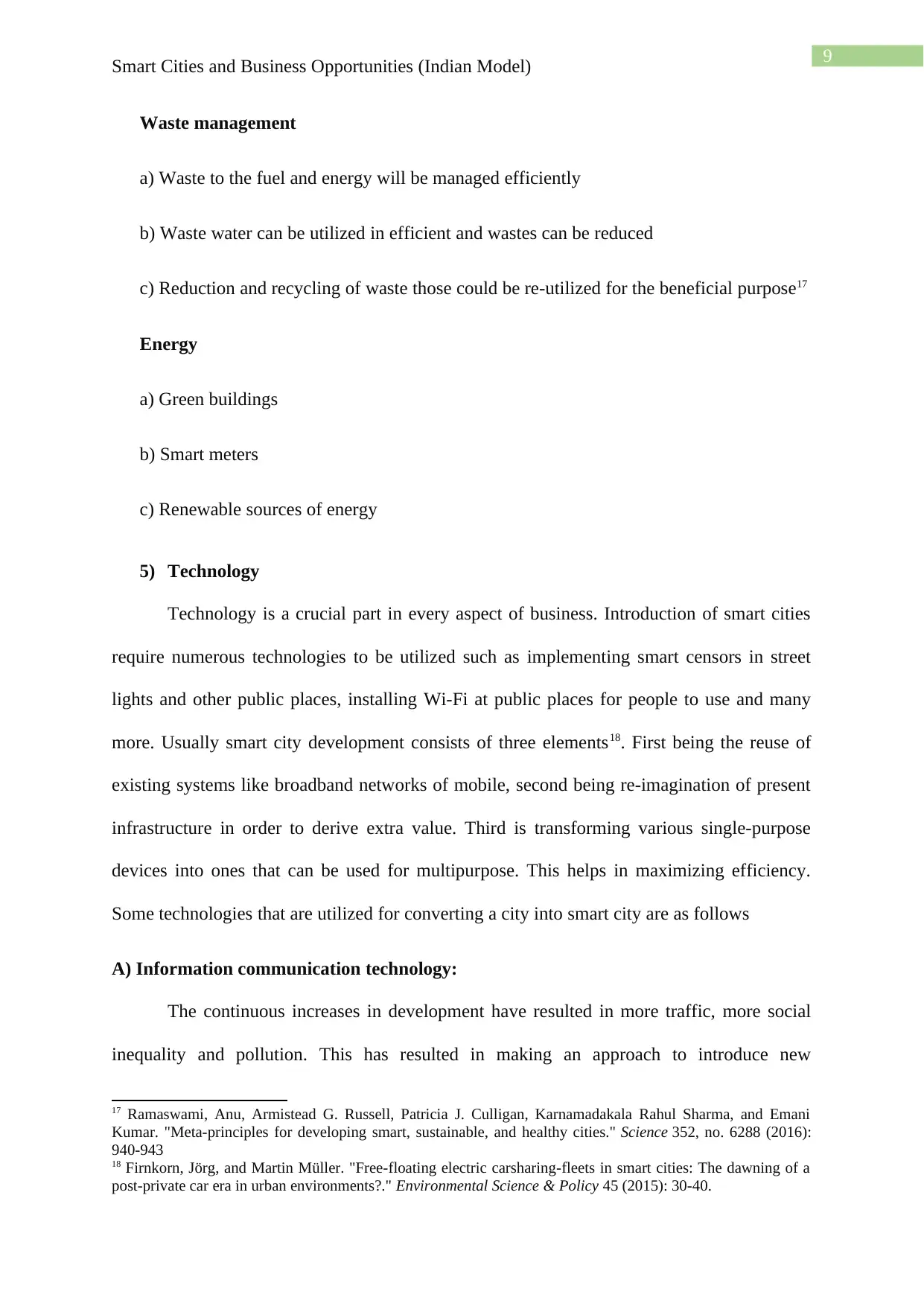
9
Smart Cities and Business Opportunities (Indian Model)
Waste management
a) Waste to the fuel and energy will be managed efficiently
b) Waste water can be utilized in efficient and wastes can be reduced
c) Reduction and recycling of waste those could be re-utilized for the beneficial purpose17
Energy
a) Green buildings
b) Smart meters
c) Renewable sources of energy
5) Technology
Technology is a crucial part in every aspect of business. Introduction of smart cities
require numerous technologies to be utilized such as implementing smart censors in street
lights and other public places, installing Wi-Fi at public places for people to use and many
more. Usually smart city development consists of three elements18. First being the reuse of
existing systems like broadband networks of mobile, second being re-imagination of present
infrastructure in order to derive extra value. Third is transforming various single-purpose
devices into ones that can be used for multipurpose. This helps in maximizing efficiency.
Some technologies that are utilized for converting a city into smart city are as follows
A) Information communication technology:
The continuous increases in development have resulted in more traffic, more social
inequality and pollution. This has resulted in making an approach to introduce new
17 Ramaswami, Anu, Armistead G. Russell, Patricia J. Culligan, Karnamadakala Rahul Sharma, and Emani
Kumar. "Meta-principles for developing smart, sustainable, and healthy cities." Science 352, no. 6288 (2016):
940-943
18 Firnkorn, Jörg, and Martin Müller. "Free-floating electric carsharing-fleets in smart cities: The dawning of a
post-private car era in urban environments?." Environmental Science & Policy 45 (2015): 30-40.
Smart Cities and Business Opportunities (Indian Model)
Waste management
a) Waste to the fuel and energy will be managed efficiently
b) Waste water can be utilized in efficient and wastes can be reduced
c) Reduction and recycling of waste those could be re-utilized for the beneficial purpose17
Energy
a) Green buildings
b) Smart meters
c) Renewable sources of energy
5) Technology
Technology is a crucial part in every aspect of business. Introduction of smart cities
require numerous technologies to be utilized such as implementing smart censors in street
lights and other public places, installing Wi-Fi at public places for people to use and many
more. Usually smart city development consists of three elements18. First being the reuse of
existing systems like broadband networks of mobile, second being re-imagination of present
infrastructure in order to derive extra value. Third is transforming various single-purpose
devices into ones that can be used for multipurpose. This helps in maximizing efficiency.
Some technologies that are utilized for converting a city into smart city are as follows
A) Information communication technology:
The continuous increases in development have resulted in more traffic, more social
inequality and pollution. This has resulted in making an approach to introduce new
17 Ramaswami, Anu, Armistead G. Russell, Patricia J. Culligan, Karnamadakala Rahul Sharma, and Emani
Kumar. "Meta-principles for developing smart, sustainable, and healthy cities." Science 352, no. 6288 (2016):
940-943
18 Firnkorn, Jörg, and Martin Müller. "Free-floating electric carsharing-fleets in smart cities: The dawning of a
post-private car era in urban environments?." Environmental Science & Policy 45 (2015): 30-40.
Paraphrase This Document
Need a fresh take? Get an instant paraphrase of this document with our AI Paraphraser
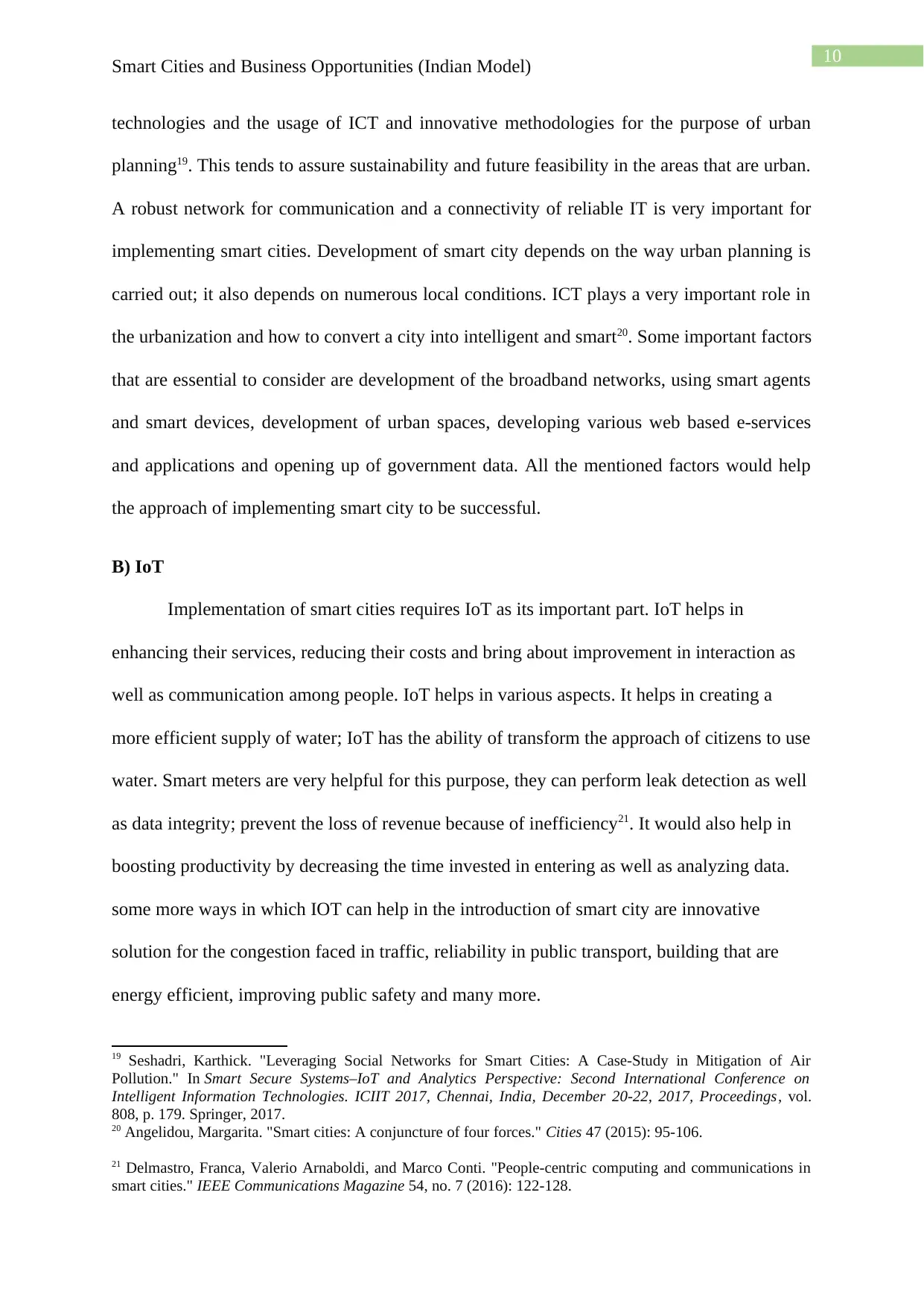
10
Smart Cities and Business Opportunities (Indian Model)
technologies and the usage of ICT and innovative methodologies for the purpose of urban
planning19. This tends to assure sustainability and future feasibility in the areas that are urban.
A robust network for communication and a connectivity of reliable IT is very important for
implementing smart cities. Development of smart city depends on the way urban planning is
carried out; it also depends on numerous local conditions. ICT plays a very important role in
the urbanization and how to convert a city into intelligent and smart20. Some important factors
that are essential to consider are development of the broadband networks, using smart agents
and smart devices, development of urban spaces, developing various web based e-services
and applications and opening up of government data. All the mentioned factors would help
the approach of implementing smart city to be successful.
B) IoT
Implementation of smart cities requires IoT as its important part. IoT helps in
enhancing their services, reducing their costs and bring about improvement in interaction as
well as communication among people. IoT helps in various aspects. It helps in creating a
more efficient supply of water; IoT has the ability of transform the approach of citizens to use
water. Smart meters are very helpful for this purpose, they can perform leak detection as well
as data integrity; prevent the loss of revenue because of inefficiency21. It would also help in
boosting productivity by decreasing the time invested in entering as well as analyzing data.
some more ways in which IOT can help in the introduction of smart city are innovative
solution for the congestion faced in traffic, reliability in public transport, building that are
energy efficient, improving public safety and many more.
19 Seshadri, Karthick. "Leveraging Social Networks for Smart Cities: A Case-Study in Mitigation of Air
Pollution." In Smart Secure Systems–IoT and Analytics Perspective: Second International Conference on
Intelligent Information Technologies. ICIIT 2017, Chennai, India, December 20-22, 2017, Proceedings, vol.
808, p. 179. Springer, 2017.
20 Angelidou, Margarita. "Smart cities: A conjuncture of four forces." Cities 47 (2015): 95-106.
21 Delmastro, Franca, Valerio Arnaboldi, and Marco Conti. "People-centric computing and communications in
smart cities." IEEE Communications Magazine 54, no. 7 (2016): 122-128.
Smart Cities and Business Opportunities (Indian Model)
technologies and the usage of ICT and innovative methodologies for the purpose of urban
planning19. This tends to assure sustainability and future feasibility in the areas that are urban.
A robust network for communication and a connectivity of reliable IT is very important for
implementing smart cities. Development of smart city depends on the way urban planning is
carried out; it also depends on numerous local conditions. ICT plays a very important role in
the urbanization and how to convert a city into intelligent and smart20. Some important factors
that are essential to consider are development of the broadband networks, using smart agents
and smart devices, development of urban spaces, developing various web based e-services
and applications and opening up of government data. All the mentioned factors would help
the approach of implementing smart city to be successful.
B) IoT
Implementation of smart cities requires IoT as its important part. IoT helps in
enhancing their services, reducing their costs and bring about improvement in interaction as
well as communication among people. IoT helps in various aspects. It helps in creating a
more efficient supply of water; IoT has the ability of transform the approach of citizens to use
water. Smart meters are very helpful for this purpose, they can perform leak detection as well
as data integrity; prevent the loss of revenue because of inefficiency21. It would also help in
boosting productivity by decreasing the time invested in entering as well as analyzing data.
some more ways in which IOT can help in the introduction of smart city are innovative
solution for the congestion faced in traffic, reliability in public transport, building that are
energy efficient, improving public safety and many more.
19 Seshadri, Karthick. "Leveraging Social Networks for Smart Cities: A Case-Study in Mitigation of Air
Pollution." In Smart Secure Systems–IoT and Analytics Perspective: Second International Conference on
Intelligent Information Technologies. ICIIT 2017, Chennai, India, December 20-22, 2017, Proceedings, vol.
808, p. 179. Springer, 2017.
20 Angelidou, Margarita. "Smart cities: A conjuncture of four forces." Cities 47 (2015): 95-106.
21 Delmastro, Franca, Valerio Arnaboldi, and Marco Conti. "People-centric computing and communications in
smart cities." IEEE Communications Magazine 54, no. 7 (2016): 122-128.
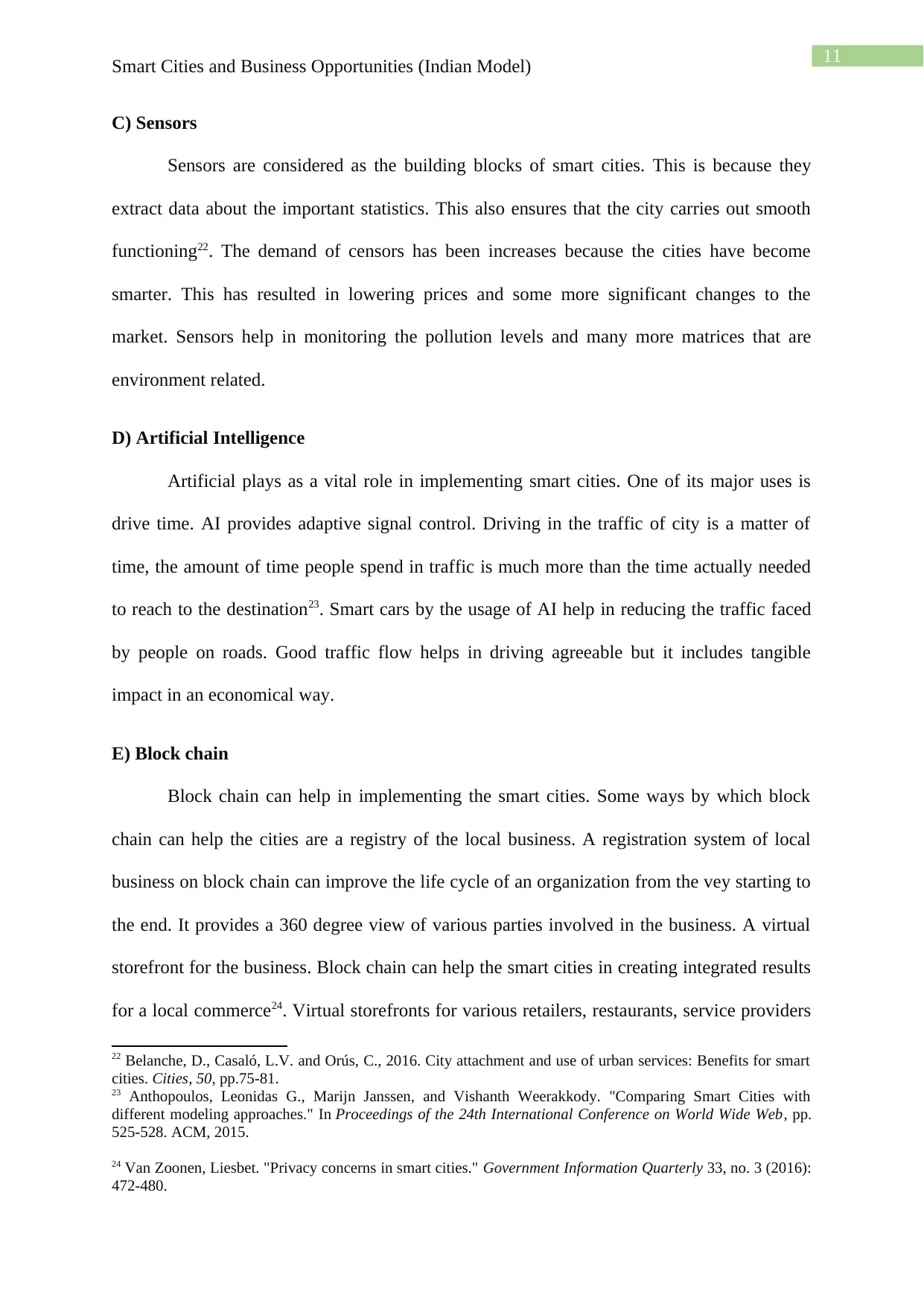
11
Smart Cities and Business Opportunities (Indian Model)
C) Sensors
Sensors are considered as the building blocks of smart cities. This is because they
extract data about the important statistics. This also ensures that the city carries out smooth
functioning22. The demand of censors has been increases because the cities have become
smarter. This has resulted in lowering prices and some more significant changes to the
market. Sensors help in monitoring the pollution levels and many more matrices that are
environment related.
D) Artificial Intelligence
Artificial plays as a vital role in implementing smart cities. One of its major uses is
drive time. AI provides adaptive signal control. Driving in the traffic of city is a matter of
time, the amount of time people spend in traffic is much more than the time actually needed
to reach to the destination23. Smart cars by the usage of AI help in reducing the traffic faced
by people on roads. Good traffic flow helps in driving agreeable but it includes tangible
impact in an economical way.
E) Block chain
Block chain can help in implementing the smart cities. Some ways by which block
chain can help the cities are a registry of the local business. A registration system of local
business on block chain can improve the life cycle of an organization from the vey starting to
the end. It provides a 360 degree view of various parties involved in the business. A virtual
storefront for the business. Block chain can help the smart cities in creating integrated results
for a local commerce24. Virtual storefronts for various retailers, restaurants, service providers
22 Belanche, D., Casaló, L.V. and Orús, C., 2016. City attachment and use of urban services: Benefits for smart
cities. Cities, 50, pp.75-81.
23 Anthopoulos, Leonidas G., Marijn Janssen, and Vishanth Weerakkody. "Comparing Smart Cities with
different modeling approaches." In Proceedings of the 24th International Conference on World Wide Web, pp.
525-528. ACM, 2015.
24 Van Zoonen, Liesbet. "Privacy concerns in smart cities." Government Information Quarterly 33, no. 3 (2016):
472-480.
Smart Cities and Business Opportunities (Indian Model)
C) Sensors
Sensors are considered as the building blocks of smart cities. This is because they
extract data about the important statistics. This also ensures that the city carries out smooth
functioning22. The demand of censors has been increases because the cities have become
smarter. This has resulted in lowering prices and some more significant changes to the
market. Sensors help in monitoring the pollution levels and many more matrices that are
environment related.
D) Artificial Intelligence
Artificial plays as a vital role in implementing smart cities. One of its major uses is
drive time. AI provides adaptive signal control. Driving in the traffic of city is a matter of
time, the amount of time people spend in traffic is much more than the time actually needed
to reach to the destination23. Smart cars by the usage of AI help in reducing the traffic faced
by people on roads. Good traffic flow helps in driving agreeable but it includes tangible
impact in an economical way.
E) Block chain
Block chain can help in implementing the smart cities. Some ways by which block
chain can help the cities are a registry of the local business. A registration system of local
business on block chain can improve the life cycle of an organization from the vey starting to
the end. It provides a 360 degree view of various parties involved in the business. A virtual
storefront for the business. Block chain can help the smart cities in creating integrated results
for a local commerce24. Virtual storefronts for various retailers, restaurants, service providers
22 Belanche, D., Casaló, L.V. and Orús, C., 2016. City attachment and use of urban services: Benefits for smart
cities. Cities, 50, pp.75-81.
23 Anthopoulos, Leonidas G., Marijn Janssen, and Vishanth Weerakkody. "Comparing Smart Cities with
different modeling approaches." In Proceedings of the 24th International Conference on World Wide Web, pp.
525-528. ACM, 2015.
24 Van Zoonen, Liesbet. "Privacy concerns in smart cities." Government Information Quarterly 33, no. 3 (2016):
472-480.
⊘ This is a preview!⊘
Do you want full access?
Subscribe today to unlock all pages.

Trusted by 1+ million students worldwide
1 out of 31
Related Documents
Your All-in-One AI-Powered Toolkit for Academic Success.
+13062052269
info@desklib.com
Available 24*7 on WhatsApp / Email
![[object Object]](/_next/static/media/star-bottom.7253800d.svg)
Unlock your academic potential
Copyright © 2020–2025 A2Z Services. All Rights Reserved. Developed and managed by ZUCOL.



